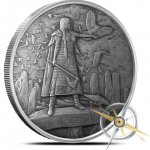
Provident recently unveiled a new series of silver rounds called Celtic Lore, featuring designs based on the folklore, myths, and legends of the early Celts. The series kicked off with Merlin, the famed wizard of Arthurian legend, and it continues with the second release, the Morrigan. All rounds in Celtic Lore showcase original artwork by Howard David Johnson, paired with the work of master sculptor Luigi Badia.
Each Morrigan .999 fine silver round will be offered in six variations: one and five ounce proof, one and five ounce antiqued, and one and five ounce colorized. Rounds come nestled in a protective box with a certificate of authenticity. Celtic Lore rounds will be produced in limited mintages from the Osborne Mint, in partnership with Anonymous Mint.
The obverse of this new round features the Morrigan, known as the Queen of Battles, standing fiercely on a stone precipice. The Celtic war goddess represents the circle of life, associated with both birth and death. Little detail about the Morrigan remains since much of Celtic mythology has been lost through time, and we’re left with conflicting texts.
For instance, some texts refer to the Morrigan as a singular figure, while other sources depict her as a triple goddess who is able to break apart into three sisters named Badb, Macha, and Nemain. This trio is often referred to as the “three Morrigna,” which is a tribute to the significance of the number three in Irish mythology.
 The Morrigan is best known for her ability to foretell doom and death in battles, during which she uses her shapeshifting powers to fly as a crow above the skirmish. She had premonitions of warriors’ deaths and the outcome of wars. In other sources, she helped protect her people from invading armies by blowing a layer of fog over the land to decrease visibility and make the terrain tougher for invaders to navigate. In addition to being a war goddess, the Morrigan was also associated with land and livestock. Her shapeshifting represents her connection with the whole living universe.
The Morrigan is best known for her ability to foretell doom and death in battles, during which she uses her shapeshifting powers to fly as a crow above the skirmish. She had premonitions of warriors’ deaths and the outcome of wars. In other sources, she helped protect her people from invading armies by blowing a layer of fog over the land to decrease visibility and make the terrain tougher for invaders to navigate. In addition to being a war goddess, the Morrigan was also associated with land and livestock. Her shapeshifting represents her connection with the whole living universe.
The Morrigan appears in the 12th century semi-historical compilation called Lebor Gabala Erenn, commonly grouped with texts of the Mythological Cycle. In these texts, the Morrigan is listed among the Tuatha De Danann, which was a mythical race living in Ireland who were said to be descended from the goddess Danu.
 The shared reverse of the Celtic Lore series showcases intricate celtic knot work that was commonly used in that period’s artwork. The ropes twist into two stylized wolf heads on each side, facing inward toward another knotted design. Inscriptions include the series name and the round’s weight and purity.
The shared reverse of the Celtic Lore series showcases intricate celtic knot work that was commonly used in that period’s artwork. The ropes twist into two stylized wolf heads on each side, facing inward toward another knotted design. Inscriptions include the series name and the round’s weight and purity.
If you’ve been collecting this set, note that the colorized Merlin round, in both one and five ounces, is now in stock and available for you to add to your Celtic Lore collection! Which design are you most excited about?




Leave a Reply